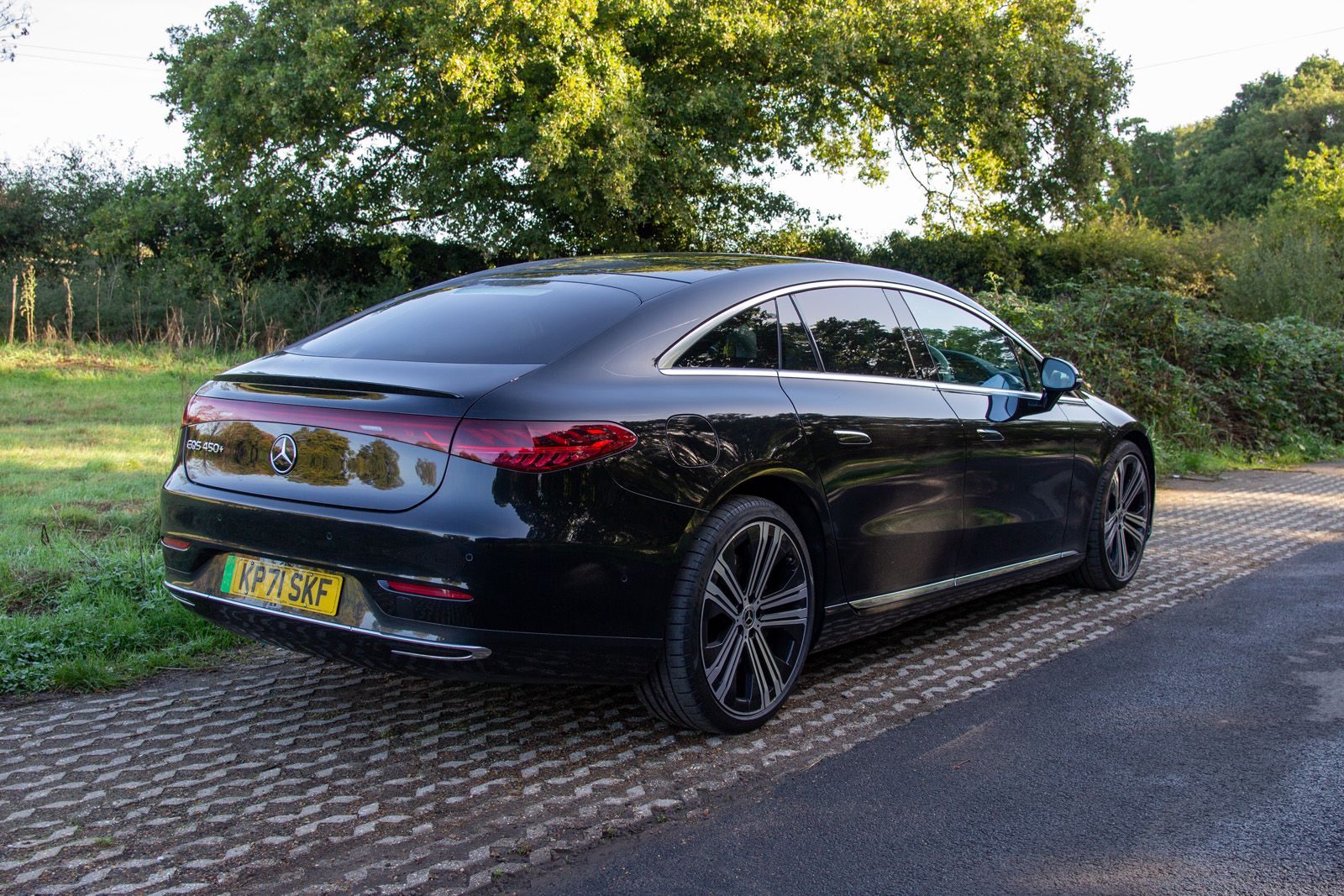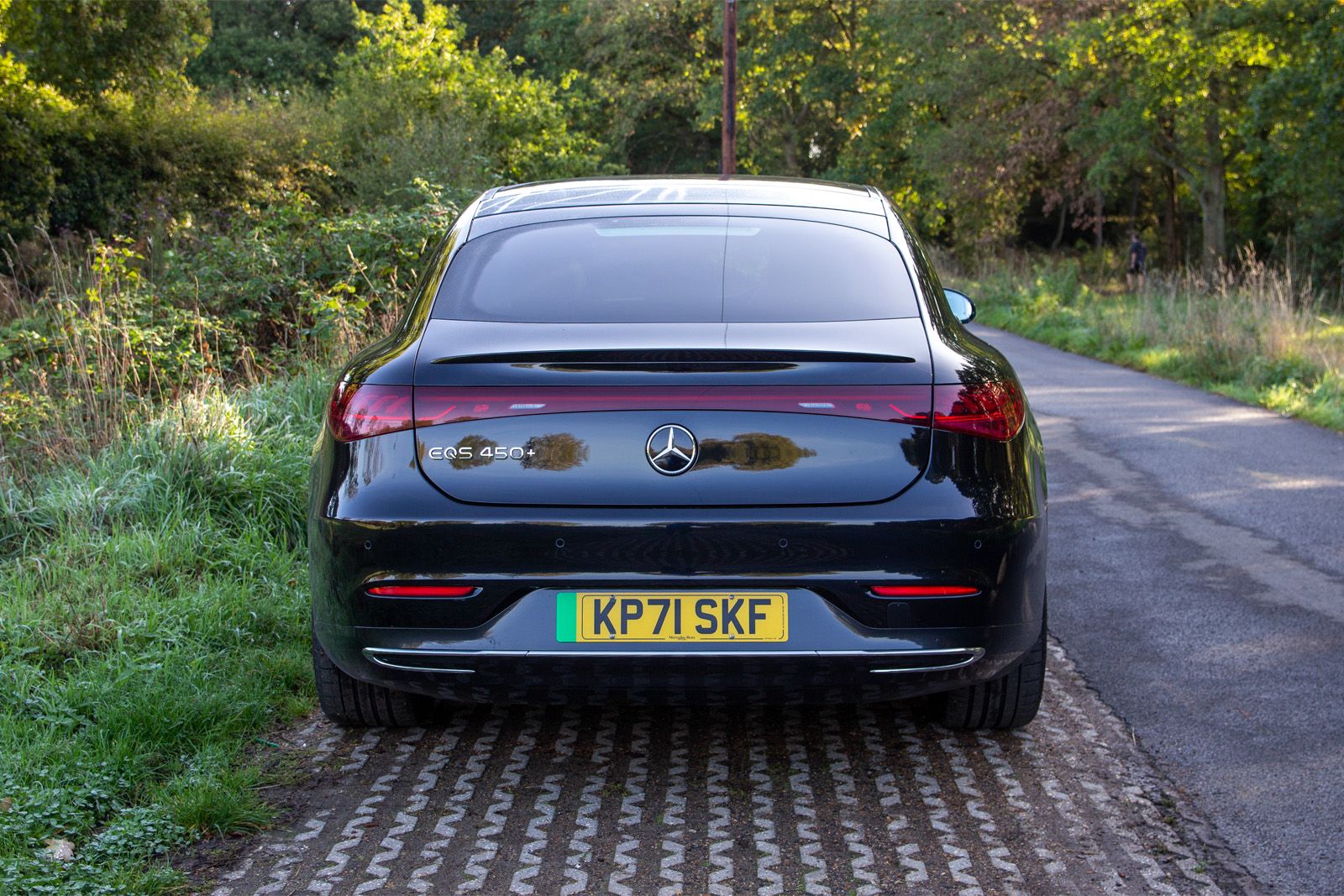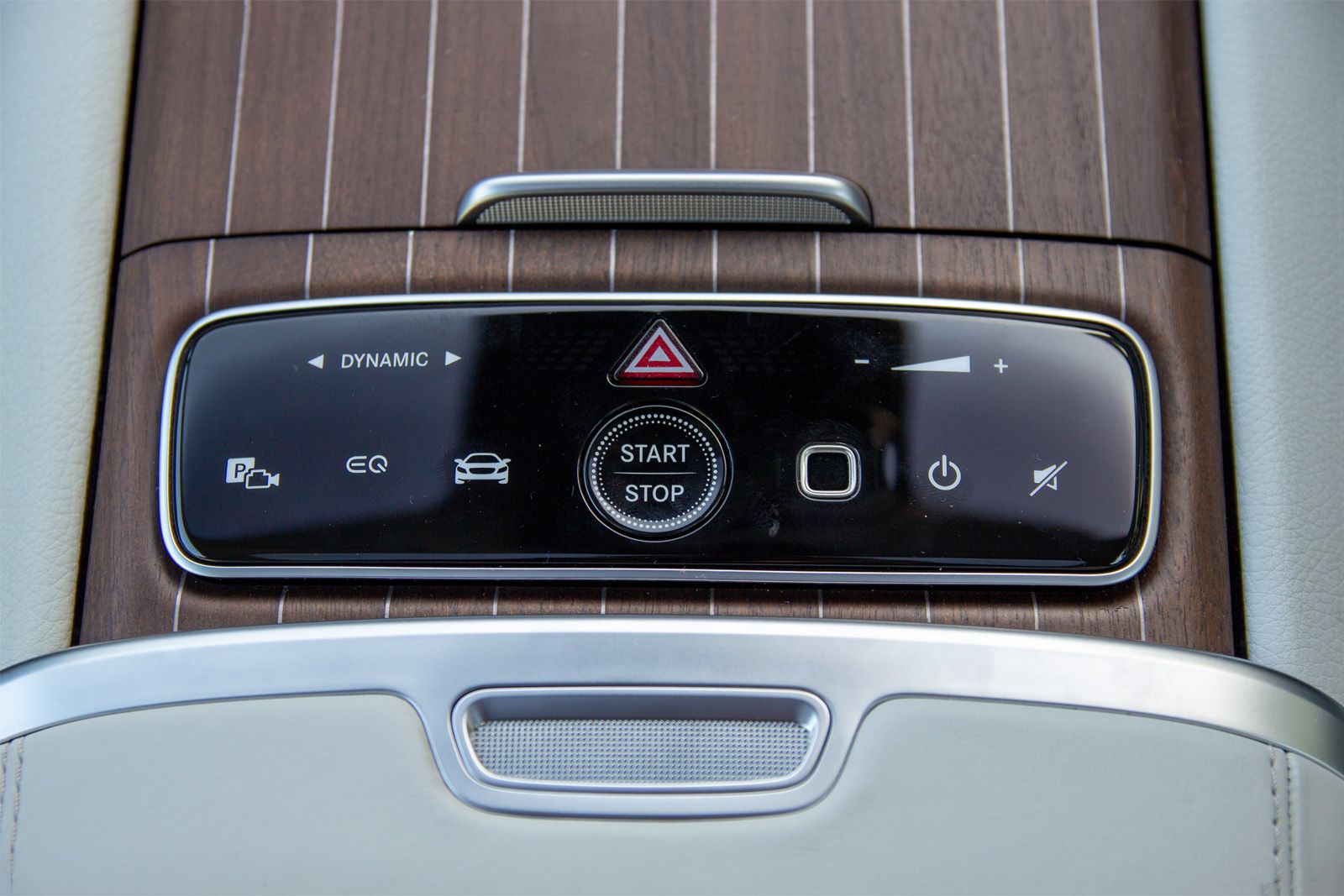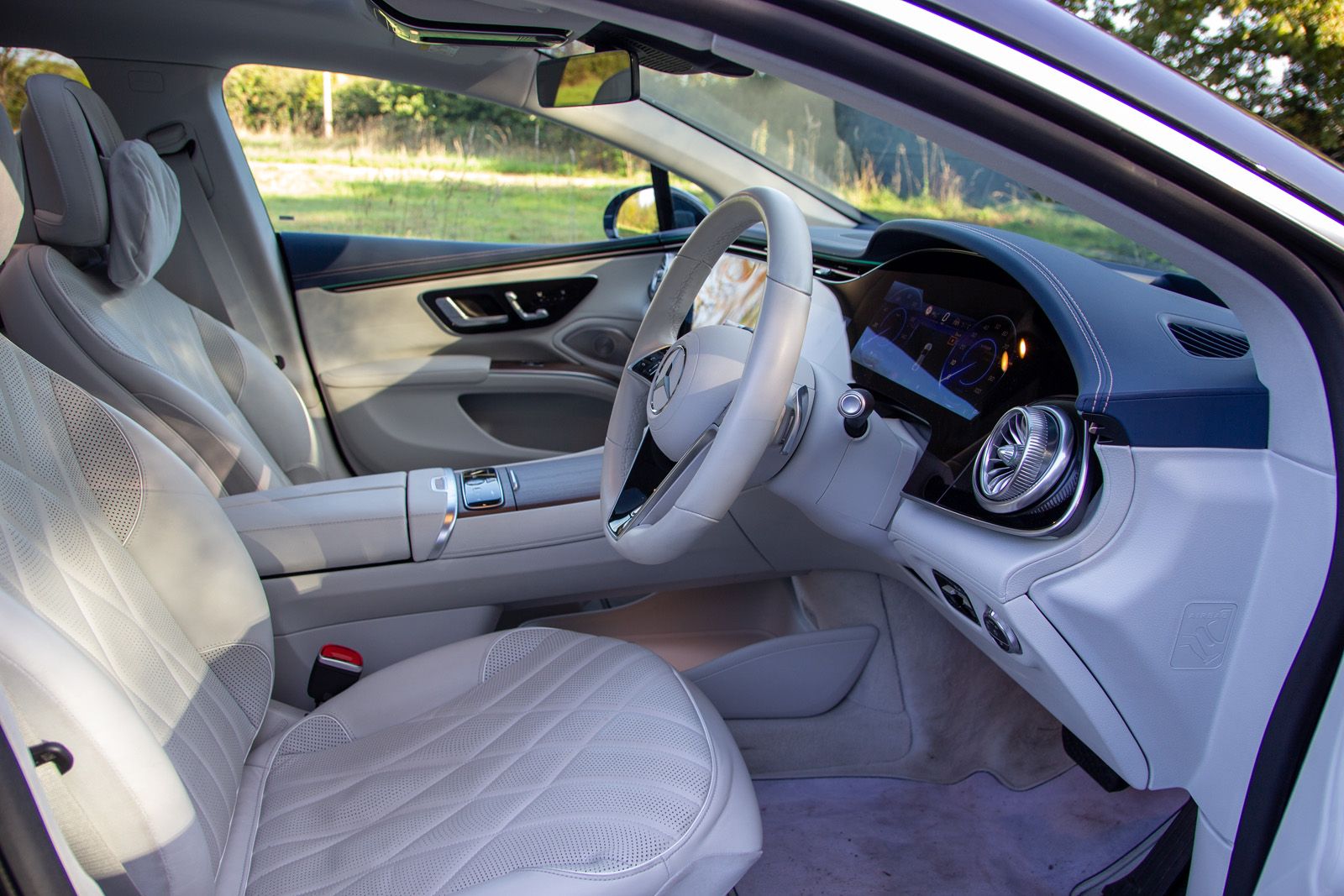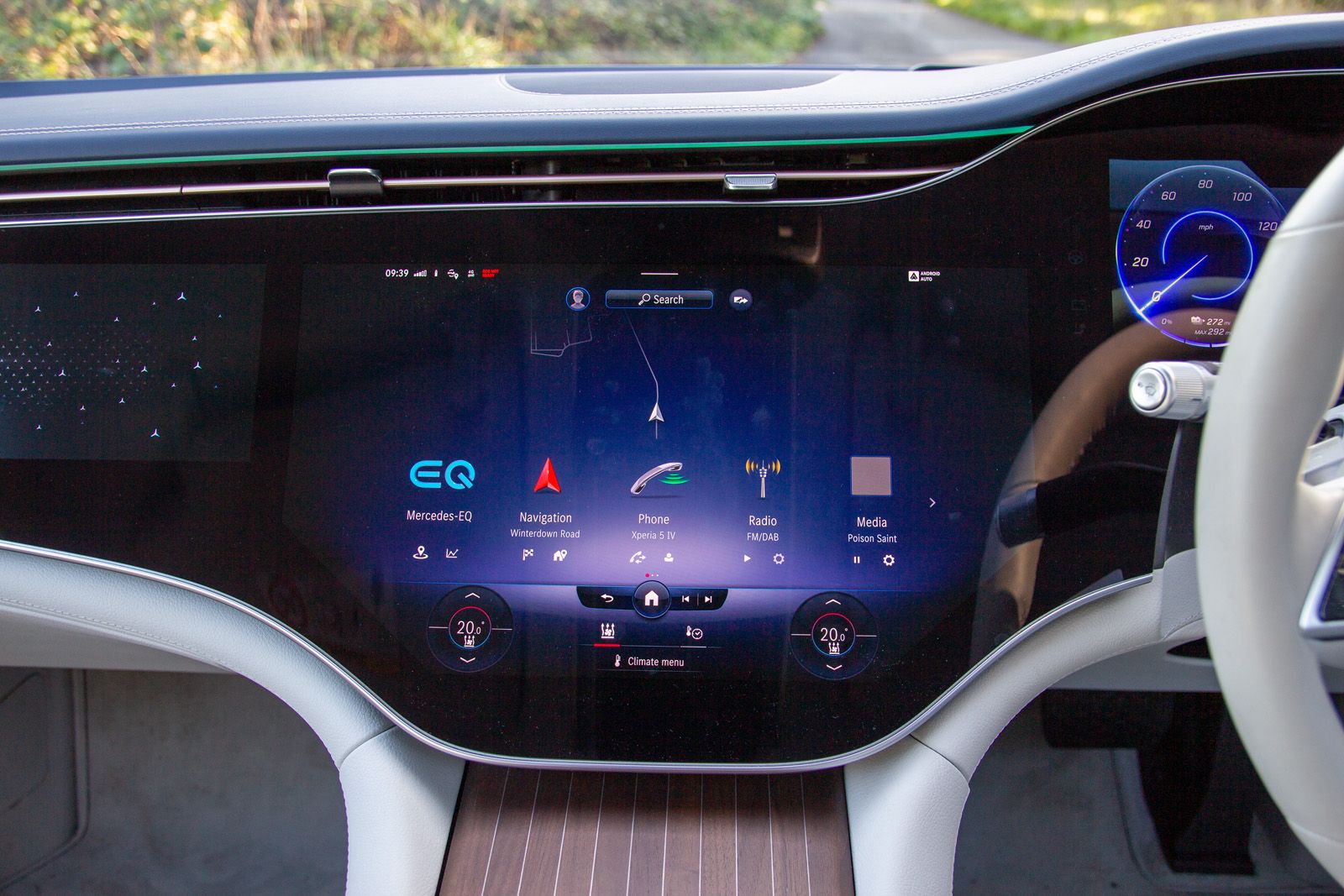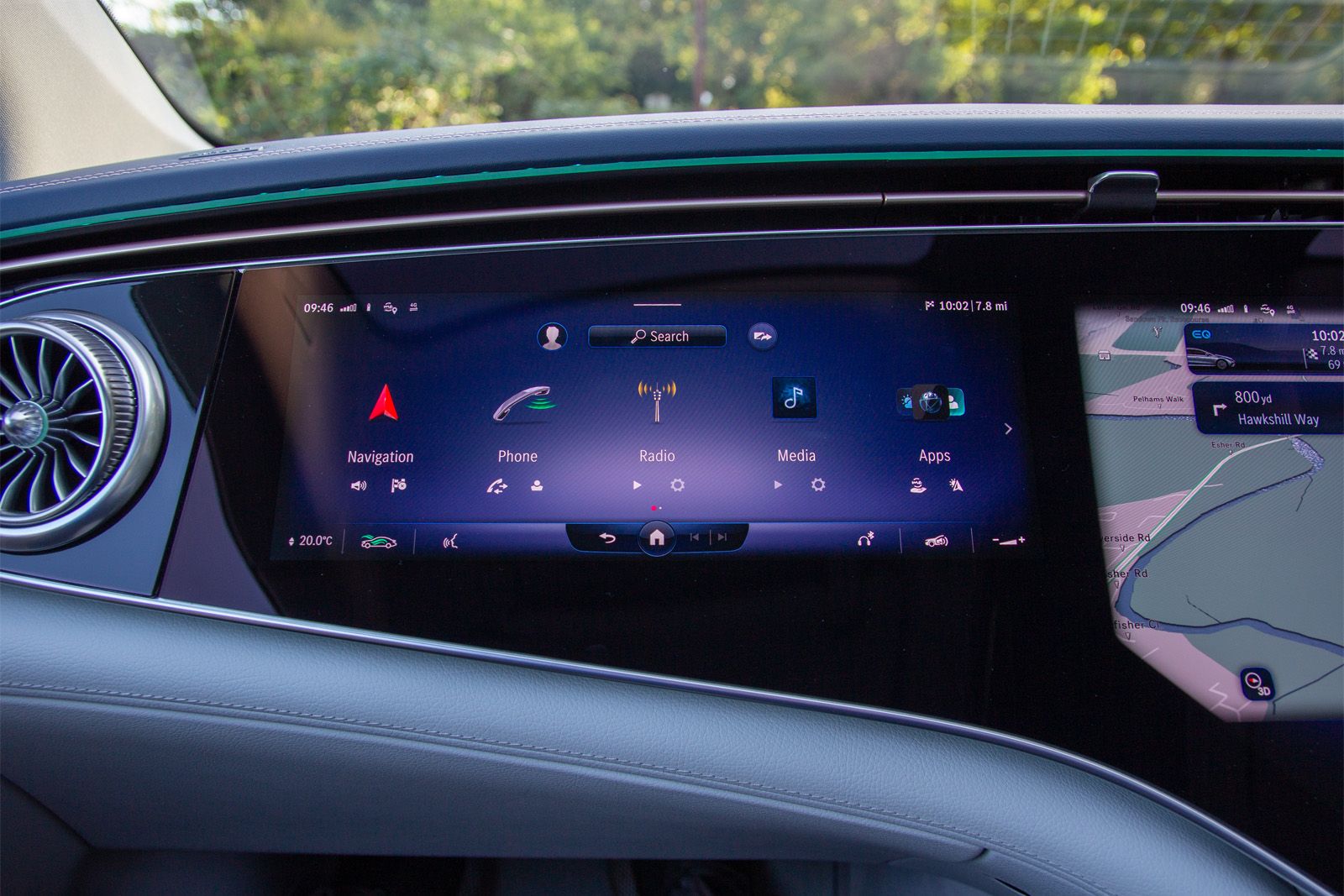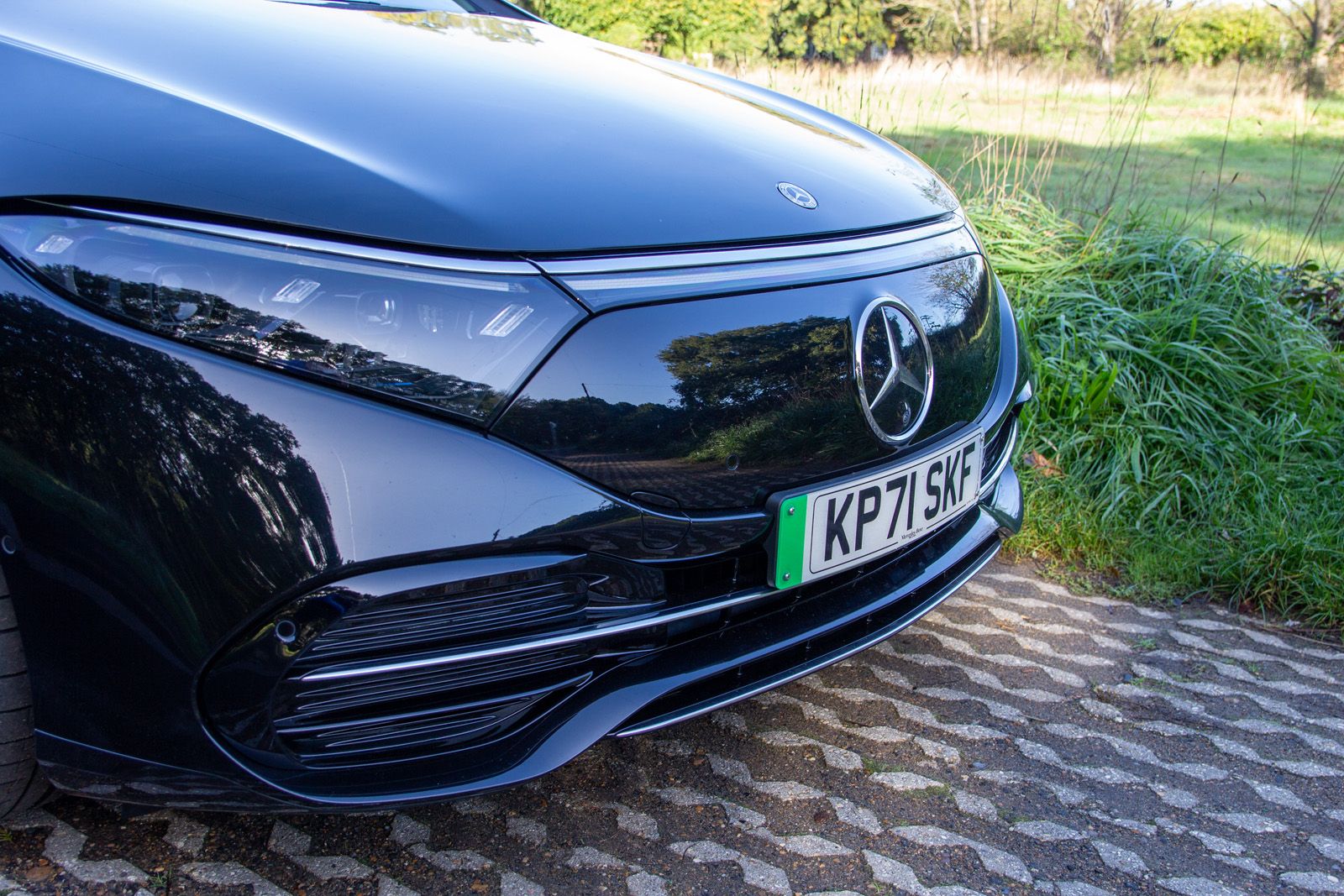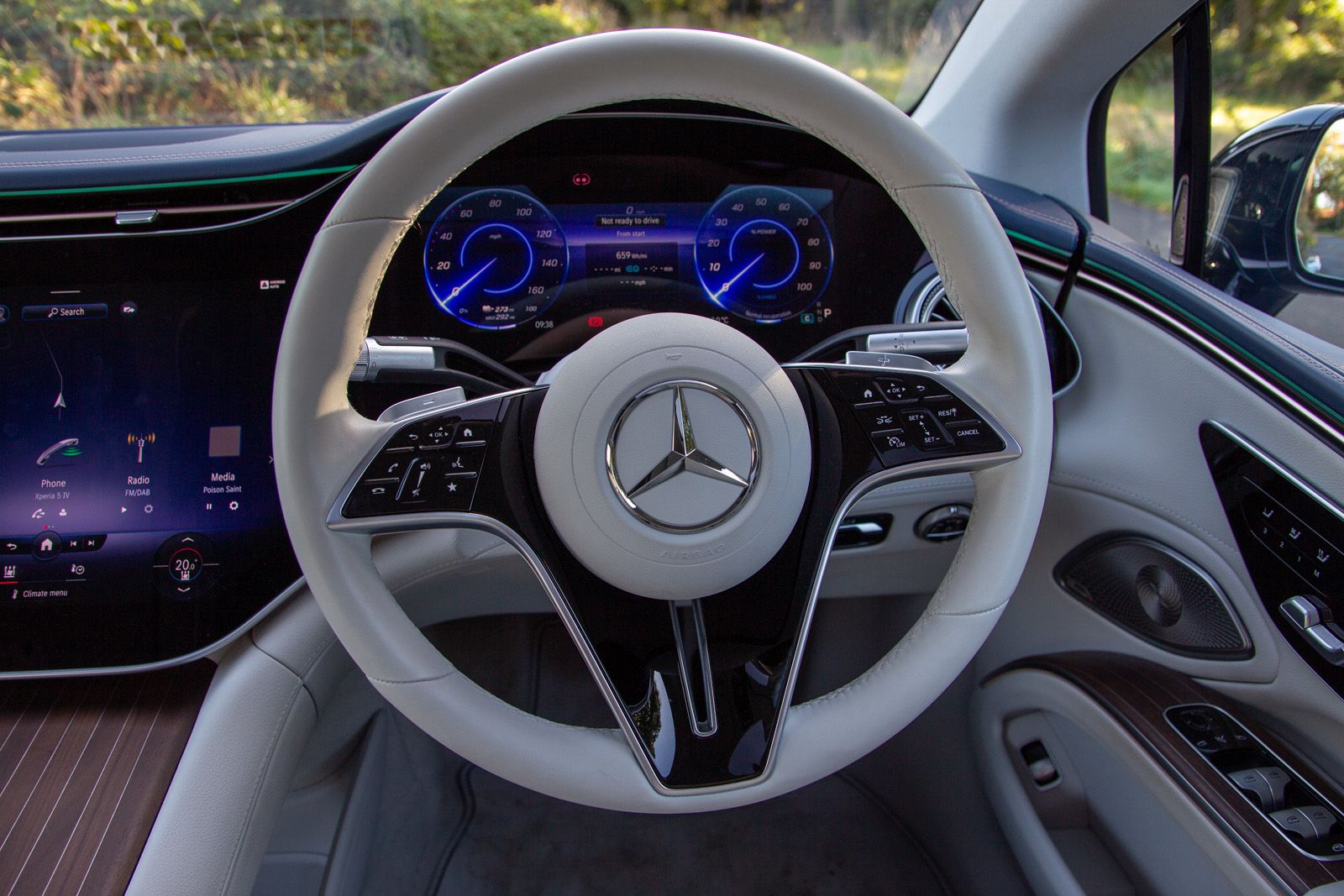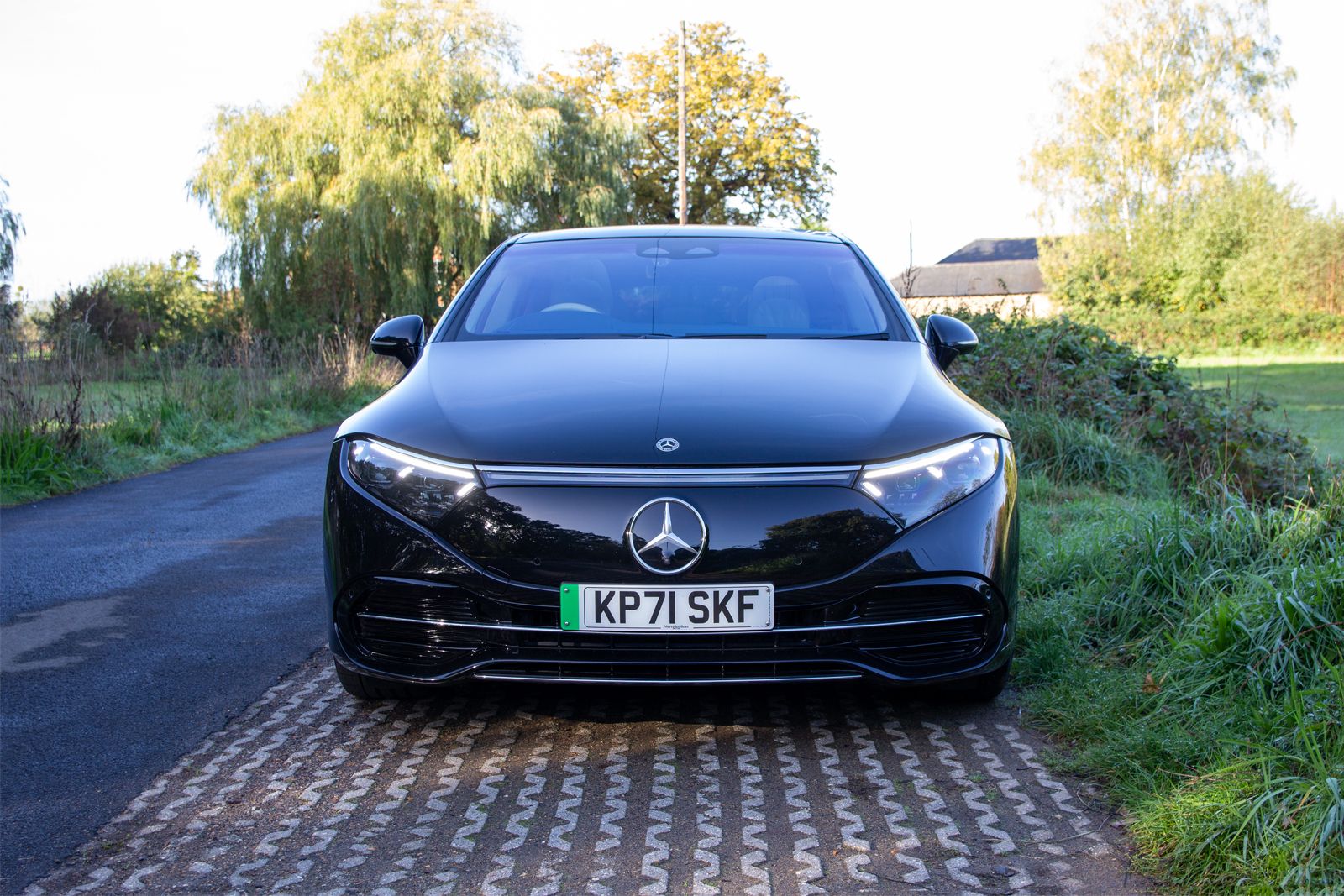Mercedes has slowly been aligning its established models with electric equivalents. The GLA became the EQA, the GLC the EQC - both in mass market SUV designs - before Merc moved onto the likes of the E Class - as seen in the EQE - and the S Class as the EQS.
The Mercedes EQS, now joined by an SUV equivalent - is the flagship electric car for Mercedes and perhaps, by some measure, a flagship car for the entire electric revolution.
It is undeniably expensive with a starting price just shy of £100,000, but at the same time, the Mercedes EQS is a masterpiece, the manifestation of long experience and engineering know-how that you expect from Mercedes.
Our quick take
When you're sitting behind the wheel of a car in a flagship position, you expect something special. There's wow factor in the Hyperscreen but it's backed up by a system that's actually great to use - and all credit to Mercedes, because it could have been terrible. Instead it's considered and intuitive.
The high levels of quality mark the EQS out from most other rivals, the focus on comfort and sophistication means it is a cut above - and that's exactly what you'd expect. There's also a wide range of options - with a wide range of prices - to get exactly the EQS you want.
But then we come to the real crunch point. The Mercedes EQS delivers in a number of areas because it can afford to. There's the space to stuff in a massive battery with an asking price that can justify it. That means plenty of boot space, plenty of interior space and importantly, plenty of range.
So the Mercedes EQS takes EVs to the extreme, delivering so much because it's expensive. But it's also a benchmark, something to aspire to and for others to replicate. We're not all going to be able to afford the EQS, but you have to admire what it is.
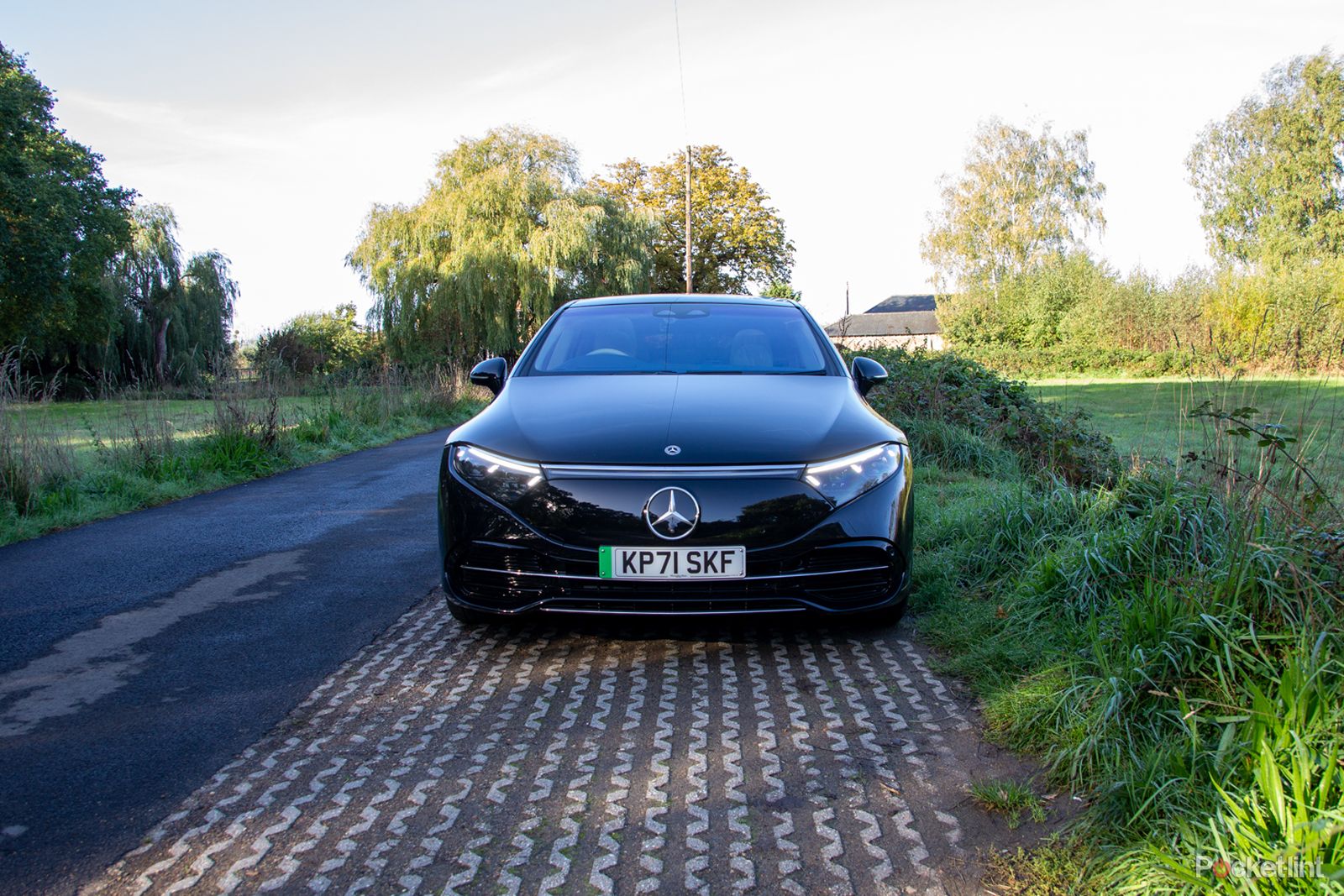
Mercedes EQS - 5.0 / 5
| FOR | AGAINST |
|---|---|
|
|
Designed with prestige mind
Sitting firming in the luxury class, the EQS is the sort of car that's designed as much with the VIP in the rear as it is the driver in the front. Some might dismiss it as a car that's only good for being chauffeured, but spare a thought for the chauffeur.
Long and low summarises the design, a sweeping line from nose to tail sees the EQS slip through the air, designed for minimal resistance. There are no sharp angles and few folds except for that sculpting of the bonnet, lovingly crafted into an aerodynamic body.
It's effortlessly elegant, the sort of car that will see heads turning, a nod of appreciation as you silently waft by.
The EQS feels like the destination that Mercedes saloons have been driving towards over the past few decades, showing the sort of balance that some earlier models had perhaps lacked. To us, it's a great-looking car, undoubtedly huge but with an understated magnificence.
The shallow rake of the windscreen sees that long line running from A pillar through to the rear of the car like a smooth pebble; the rear of the car itself sporting a subtlest of spoilers, while huge 22-inch wheels give it road presence.
Finished in the top-spec Exclusive Luxury trim as seen here, the focus is on luxury rather than appearing sporty, which is available if you opt for the lower-level AMG trims. That's right, in the world of the EQS, the AMG is the entry level, before you step up to something more sophisticated - although there are plenty of options to customise the Merc to your liking.
Interior: A class apart
There's a change of character when you climb into the interior of the Mercedes EQS, from that understated elegance of the exterior to sumptuous luxury. The interior of the EQS is designed to be showy, with premium materials and textures, high quality finishes fusing wood and leather. Of course, opt for this Neva Grey with Biscay Blue Nappa leather, with ship's deck open-pore walnut wood and your greatest concern is likely to be how you keep those thick carpets clean. You could opt for a dark interior, but the contrast between the purity of the black exterior and the light and open interior, we really like.
Starting in the rear of the car, there are acres of space, with lots of legroom, as this car has been designed to accommodate high flyers in the rear in comfort. There's no worry about knocking knees, while the floor is essentially flat, so if you do need to slide across out of the other door, there's nothing in the way.
Such is the advantage of having a car sitting on a platform that's purpose designed for an electric powertrain, and that's what we see in the front too. While the layout is similar to any combustion car, with a central console in place, there's storage space beneath it with a large tray - even equipped with an elastic strap to keep things secured.
On this trim of car there's a 64-colour ambient lighting system that highlights pretty much everything, including around the edges of the front seats, while the leathers are of high quality, finishing just about every surface.
The deck of the centre console retracts to reveal the cupholders, wireless charging bay for your phone and other storage, while the armrest offers more storage and more connection points for your phone.
Normally, that wood effect (or other material depending on the trim you select) would expand across the dash too, flanking the central display, but one of Mercedes' additional options is the MBUX Hyperscreen as seen in our test car. It's an £8000 option but it does, again, transform the car into something much more futuristic, which we'll talk about in the next section.
The EQS is designed to be comfortable and it really is, with plenty of seat position controls, which can be linked to your profile. There's even an automatic option where you can give the car your height and it will adjust the seat and steering wheel into what it thinks is a good driving position for you.
These seats are really comfortable, with heating and ventilation offered in the front, as well as a range of heated massage options to revive you on longer drives.
There's a big leaning towards personalisation, because your profile remembers all your settings, and thanks to face recognition technology (which doubles up a driver alertness monitoring) when you sit in the car, it will recognise you, say hello and launch your profile, which is great for those who share their car with someone else.
Many of the controls on the EQS are designed for touch rather than clicking so you'll find you have to swipe across some of the controls on the steering wheel, for example, while the sunroof and shade are controlled with a swipe along that controller.
Alongside all that cabin space there's also a huge 610-litre boot, so there's plenty of space for all your luggage too.
Let's talk about the tech
The normal car has a 12.8-inch central display paired with a 12.2-inch digital driver display, but with optional Hyperscreen, the front dash is replaced with a seamless glass sheet, behind which is set the driver display, an expanded 17.7-inch central display and an additional 12.3-inch passenger display.
The effect is striking, giving the Mercedes EQS a space-age look, like you're sitting in the cockpit of a spacecraft. The addition of haptic feedback on touch enhances the experience, making touch interaction really positive.
Too often we've found that cars dominated by touch experiences feel a little indistinct, but Mercedes MBUX manages to avoid this through its sophistication and through a user interface that's intuitive enough to use with very little learning curve.
If there's one criticism, it might be that the angle of the driver display is perhaps a little odd and it can be prone to reflections although it has the brightness to cut through those. The downside of having so much display is, of cours,e the distraction it might potentially cause; indeed, on startup there's a notification warning you not to be distracted.
Thanks to a heads-up display all the important information is in your eyeline so you don't need to look into the car, but having a larger display means larger icons and that generally means it's easier to hit what you want first time. While on the heads-up display, this provides plenty of information, but we found that the trim around the opening for the projector could catch the sun, leaving an addition reflection on the inside of the windscreen. Importantly, this heads-up display works when wearing polarised sunglasses, so it's better to use than some others - on the Range Rover for example.
The MBUX system is also supported by Android Auto and Apple CarPlay, but this is one instance when we'd say you don't need to use those systems because MBUX is a better experience in its native form. That's not to stop you connecting your phone and using those services in the background (there's always an icon on the display so you can jump back to it), but if you're navigating with Google Maps, for example, those directions won't be shown on the heads-up display so you miss out.
The addition of a passenger display is interesting as it means that whoever is sat in that seat can access things like mapping to search for destinations rather than doing it on the central display, but there's also access to things like games to keep them entertained.
Again, don't worry about this being a distraction for the driver, because those cameras we mentioned that will log you into your profile will also detect when you don't have your eyes on the road and will shut off the passenger display so you're not tempted to look over and help with a sudoku puzzle.
There's also a lot of tech that's designed to keep you safe on the road and to assist you as you drive, which we'll talk about now.
The driving experience
We're moving closer to the day that the car drives you rather than you driving the car and the Mercedes EQS joins the ranks of really smart cars that will offer a lot of assistance. Before we get to that, however, let's run over the basics of what powers this car.
There's a massive 108.4kWh battery offering 200kW charging, with Mercedes claiming a 453-mile maximum range. We were closer to 400 miles with a full charge and even with long motorway driving at higher speeds, we were still getting over 350 miles from it, which is a really practical - the sort of range where you'd need to stop for a break on a long journey rather than behind forced to because you needed to charge.
When it comes to charging, Mercedes has taken the solid approach of putting a search button for chargers at the top of the map, so on any journey you can hit this button and within a few taps, you'll be navigating to the closest charger along your route. You can even filter by charging speed. This isn't a perfect experience, because the database of chargers often includes those on private estates or workplaces, but it's a comprehensive offering nonetheless.
The EQS 450+ on review here is powered by 245kW motor driving the rear wheels, offering 0-62mph in 6.2 seconds, while the EQS 53 4MATIC+ jumps to 484kW and 0-62mph in 3.8 seconds, which is really moving, using a dual motor arrangement.
The Mercedes EQS drives in almost complete silence as you'd expect and even at high speeds on the motorway there's very little noise. You can place a call and the person on the other end will have no idea you're in a car - and you won't have to shout. There's the option to turn on a synthetic noise, so that when you put your foot down you'll get something back, but otherwise it's a case of wafting along with a sense of tranquility.
That's not unique to the EQS: all electric cars have the benefit of reduced noise, but combined with suspension that will ease away broken road surfaces, soften those speed bumps while avoiding wallowing when you get onto more aggressive roads, it's never uncomfortable.
Driving the EQS, then, is easy, with plenty of tech to warn you about what's happening around the car, including access to the sort of 3D vision of the roads that Tesla drivers will be familiar with. This can be accessed on the display, if you want it. It's nice to know that the car is keeping an eye out for you, but it's also nice not to have to look at it all the time.
It has a more practical application when it comes to cruise control, as the EQS can change lane for you when you move the indicator. It will check its clear and then steer you into the lane you want, all as part of the adaptive cruise control experience. In Europe, lane changing is slower due to more legislation than there is the US. But offering to steer the car and change lane, it's an advanced level 2 offering.
While this is a step closer to autonomous driving, it's not all perfect. The automatic sign recognition can be fooled by trucks with speed stickers on the rear - we sometimes found that when overtaking these the 60 badge on the back would be detected and the Mercedes would slow to this speed - annoying when you're supposed to be doing 70.
It also had a habit of spotting an overtaking car and slowing down, thinking that car was about to pull in front. This is indicated in the heads-up display and you'll see a line curving up the side of the on-screen display which vanishes when the car has passed. In open roads, the automated systems are great, but when it gets busier, you might need to be a little more involved to avoid them getting spooked.
The big takeaway is the sophistication and tranquillity of the drive. There's plenty of power, effortless comfort, and all in a car that's actually great to drive and great to be a passenger in. It's relaxing, because the car takes care of pretty much everything. But we're not totally sold on the intelligent regeneration option. Using the paddles on the steering column you can adjust the strength of regeneration, which manifests itself in the braking effect when you lift off the power.
The intelligent regen system aims to use a range of factors to make things a little more automated, so you have less regen on the motorway for example and increased around town. However, we found it wasn't a very smooth experience, because the car will sometimes apply harsher regen than it needs to in some moments, meaning you might decelerate fairly rapidly on lift-off, when you don't always need to. That will see you putting your foot back on the power. As a result, we found it better to stick to one of the manual options - this means you know what regen you're going to get when you lift off - and you can always avoid the problem on the motorway by using cruise control instead for a smoother and more predictable driving experience.
At the same time, the EQS has been designed for comfort and if you're looking for something to throw through the corners, this isn't really the right model for that and you'll find the steering a little too light and indirect.
To recap
The Mecedes EQS wants to set the standard for luxury electric motoring and it has plenty to offer: there's quality, refinement and great looks, boosted by really good range and a driving experience that will put a smile on your face. There's sophistication in the infotainment system and that Hyperscreen, although expensive, is a futuristic upgrade to give you something really special. For those who spend plenty of time behind the wheel, there are few nicer places to be.

